It’s Huge on Instagram. Rich People Absolutely Hate It. I Had to See It Myself.
- Oops!Something went wrong.Please try again later.
The day’s heat was still radiating off the dark stone of the Palm Springs Art Museum as revelers arrived for the museum’s spring exhibitions party. The older generation sported expensive-looking cosmetic work, the younger one extensive tattoos. All wore their finest slinky jewel tones. (The dress code was “spring noir.”) In the museum’s atrium, the drag artist Skynsuit led an invigorating performance of what I can only describe as demoness aerobics. And everyone had an opinion about the topic of the moment: Marilyn Monroe.
“I’ve lived here 25 years, and I think she’s great,” said Greg Robertson, a real estate agent. “She belongs here. We love her.” I asked why Marilyn belongs in Palm Springs, specifically, and he thought about it for a moment. “She typifies the Palm Springs attitude,” he said, finally. “Very carefree.”
“Stop harassing her!” said his date, Frank Navi, putting his fist down on the table like a judge’s gavel. “She stays.”
They were not speaking of the actress who had died some six decades earlier, but of a 26-foot-tall statue of her that was recently placed on the street in front of the museum. The statue reproduces the famous Seven Year Itch photo of the star holding down her dress as it’s blown by a gust of wind. If you see the statue from behind, though—for example, if you were to walk out the front doors of the art museum—you would see right up her windblown dress, her underpants-clad ass five times larger than life. You might find this particular detail loving or perverse, depending on your perspective.
And everyone here does have a perspective on Forever Marilyn, as the sculpture is titled. Catherine and Michael Mahon retired to Palm Springs in 2009. “The statue does not belong where it is,” Catherine said. She was wearing a beautiful magenta-and-orange headscarf and eyeglasses the size of Robert De Niro’s driving goggles in Killers of the Flower Moon. Her husband’s shirt was decorated in scores of bright paint swatches. “When the deal was made, there was supposed to be a view of the museum, and it blocks the museum.”
“It’s a huge kitsch piece,” Michael pronounced.
“Which is cool, and I get the appeal,” Catherine said. “If it was just moved over 50 feet or so, I wouldn’t mind it at all.”
Taka Tachibe, an architect visiting from Los Angeles, stood in front of a striking Nan Goldin photograph. “It’s a spectacle,” he said of Marilyn. “But how is it any different from a Jeff Koons?”
River Huerta, a crisis counselor, laughed next to him. “Well, I don’t like Jeff Koons, and I don’t like the Marilyn,” he said.
“It’s sort of a vestige of Old Hollywood,” Tachibe said. “Does it have that much to do with what Palm Springs is actually like now?”
“Marilyn’s huge in Palm Springs,” insisted Chelsea Sphere, a burlesque artist, standing nearby. “We get a lot of requests to do Marilyn.”
But her performing partner, Miss dd Starr, was willing to see the other side. “I get why the statue is fraught,” she said. “Because it’s sexualized.”
“But she was a sex symbol,” Sphere pointed out.
“When she did that shoot in New York, with the dress”—Starr acted it out, delivering a camera-perfect smile—“was she being exploited? Or did she enjoy performing, enjoy the attention? I think she loved it.”
“I think the statue is art,” Sphere said. “After all, the purpose of art is to make people feel something.”
Gil Rose reached a different conclusion. “Art is supposed to evoke an emotion,” he told me. “That”—he pointed toward the front door—“does not. It evokes nothing.”
It evokes annoyance, I pointed out. “I don’t know that annoyance is an emotion,” he said.
Rose and his partner, Stan Russell, are art collectors, and have the kind of house that shows up in magazines from time to time. Russell was more circumspect. “Marilyn was a nomad,” he murmured. “So why are we anchoring her, shackling her here? We should let her move around to new locations.”
“Tourists love her,” Rose allowed.
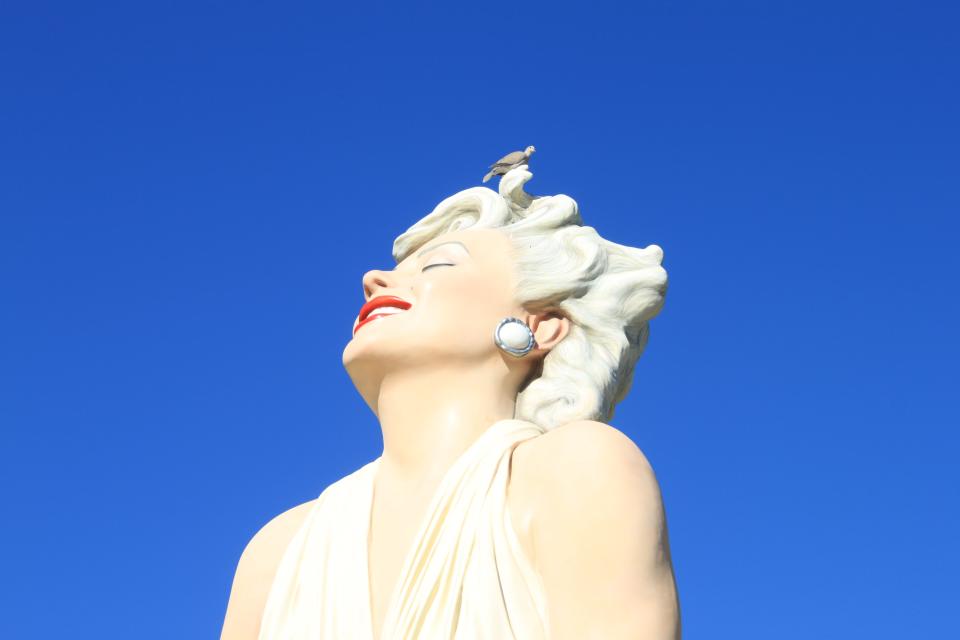
I left the museum as the party started heating up, and even outside you could hear music echoing off the San Jacinto Mountains. From the front door of the museum, it was a straight shot down Museum Way to Marilyn, and Rose was right—even at this late hour, visitors were lined up to take photographs with her. Her white dress glowed under the lights. Constructed of aluminum and steel, she stands astride Museum Way, her face a permanent grin of delight. Pigeons often perch atop her perfect blond hair.
Some people in Palm Springs are not happy about this statue. Some people are so unhappy they’ve filed a lawsuit to get it moved. The suit has cost the city hundreds of thousands of dollars over three years and still isn’t resolved. A colossal statue of a midcentury sex symbol has pitted Springsian against Springsian, as wealthy residents used to getting their way find themselves in a battle over art, sexism, and small-city politics that can have only one winner. I came to Palm Springs for a weekend to answer what turned out to be a difficult question: As much of America is engaged in battles over very different statues that evoke its past, why is this one making so many fancy people so crazy?
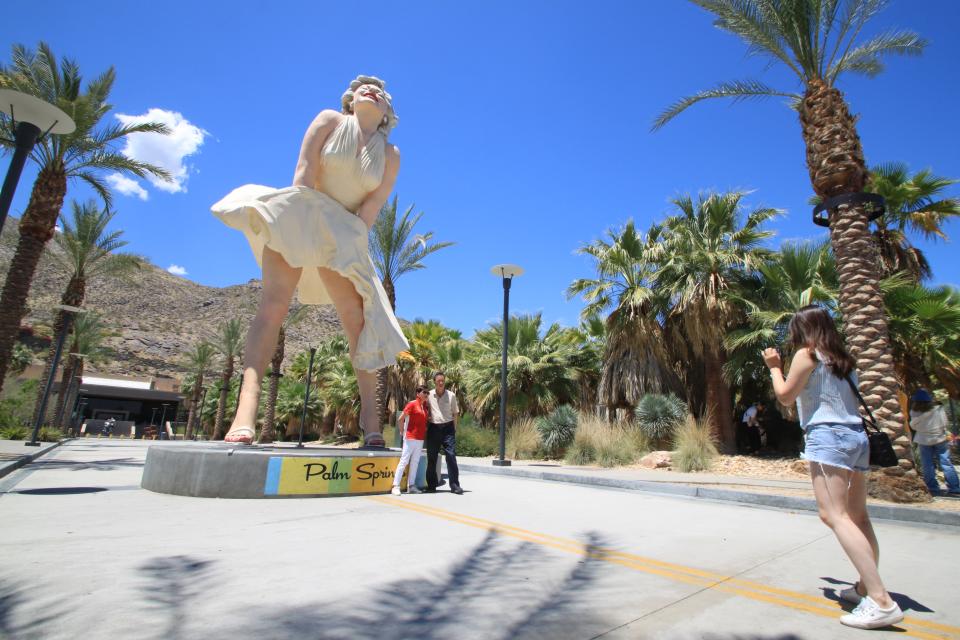
Perhaps there was a simpler question to start: Is Forever Marilyn art?
“Well, it is to some people,” said Trina Turk the morning after the party.
“There’s people that say yes, and there’s people that say no,” said Chris Menrad. Turk, a clothing designer, and Menrad, a real estate agent, are two of the leaders of CReMa—the Committee to Relocate Marilyn.
“It’s a tourist attraction,” Turk said.
“And the artist—well, you can read all about him,” Menrad said.
“I don’t think you should call him an artist,” said Turk.
“Well, a lot of the art world doesn’t, really.”
Seward Johnson, who died in 2020, was an heir to the Johnson & Johnson fortune. He made his own name as a trompe-l’oeil sculptor; his clever statues of everyday people brighten up plazas and parks from Oregon to New York to Australia. One statue, of a businessman sitting on a bench across the street from the World Trade Center in New York City, was reportedly mistaken by Sept. 11 rescuers for a survivor in need of assistance. The works are often dismissed by critics—Robert Hughes called Johnson’s statues “chocolate-box rubbish,” and said they only appeal to “dull corporate minds like his own.” But many of the statues are broadly popular, even beloved, becoming civic mascots of a sort—understandably so, given the approachable wit and humanity they display. (Visitors often put baseball caps on them and take their photos.)
Johnson’s work became more eccentric late in his career, after he undertook one of the most notorious inheritance battles of the 1980s: He and his siblings spent three years and millions of dollars fighting their late father’s third wife for a $400 million fortune. (In the end, each child received $6 million.) In the 1990s, Johnson started using computers to design larger-than-life 3D replicas of famous paintings like Manet’s Olympia. When D.C.’s Corcoran museum mounted a show of Johnson’s impressionist recreations—a show that now seems positively sedate compared to the whirling Van Gogh “experiences” on display in many major cities—the Washington Post’s critic, in a memorable review, called it “really, really bad,” and also “hideous and dumb,” and also “the worst museum exhibition I’ve ever seen.”
Undaunted, Johnson began crafting monumental replicas of notable pop-culture moments, including the famous “kissing sailor” of V-J Day. Casts of that statue have appeared in Times Square, at Pearl Harbor, and in Sarasota, Florida, where someone crashed a car into its base and someone else scrawled “#MeToo” on the woman’s leg.
Forever Marilyn, which Johnson made in 2011, is in a similar vein, and attracted both positive and negative attention in its peripatetic life even before it landed at its current home on Museum Way. (In Chicago, it was vandalized three times.) In 2012, P.S. Resorts, a nonprofit organization dedicated to boosting tourism in Palm Springs, brought Marilyn to a downtown corner. She was a hit. It was in the early days of Instagram, and visitors loved taking photos in front of Marilyn—or, yes, sometimes underneath her, pointing up at her underpants with a grin.
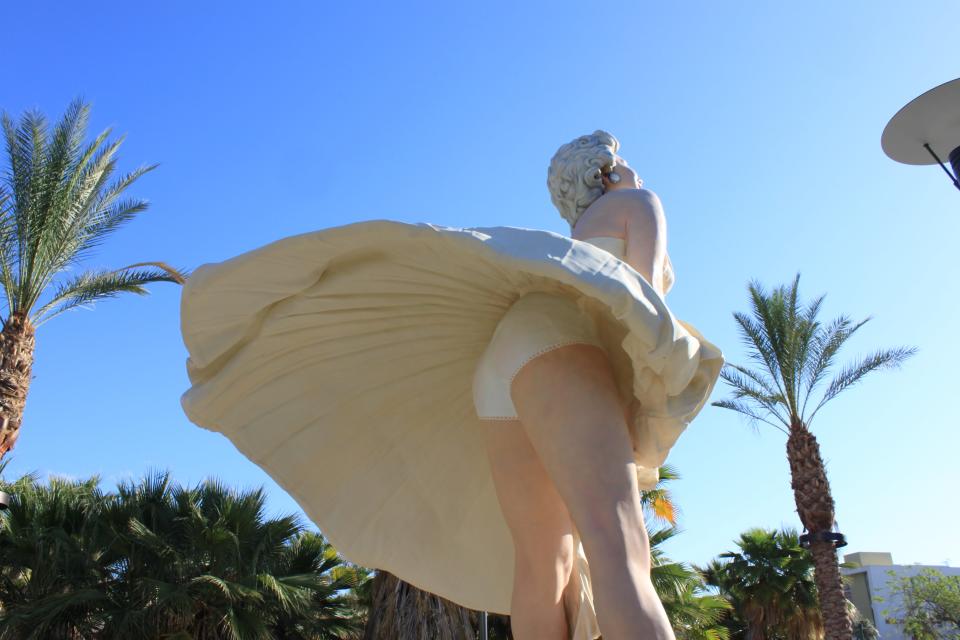
She departed in 2014 for Johnson’s sculpture park in New Jersey. (A similar, slightly larger statue, which ended up face-down in a Chinese garbage dump, was a knockoff.) Forever Marilyn also did stints in Australia and in Stamford, Connecticut, where worshippers at the First Congregational Church discovered, somewhat uncomfortably, that her rear end faced their front door. “The question for each one of us is, ‘What will you do with your discomfort?’ ” the church’s pastor told a reporter. “I am choosing grace.”
As Marilyn traveled the world, Palm Springs embarked upon an enormous downtown redevelopment project, guided by a 2016 city plan that emphasized the E. Stewart Williams–designed art museum as a centerpiece, tied to the city’s profile as a home for midcentury modern design. A ghost-town indoor shopping mall was demolished and the former street grid was restored—including reestablishing Museum Way, meant to create a clear line of sight from downtown’s main drag all the way to the museum. Then, in the fall of 2020, Trina Turk got an email from a friend—E. Stewart Williams’ daughter-in-law, in fact—telling her that P.S. Resorts had convinced the City Council that the perfect location for Forever Marilyn’s return was smack-dab in the middle of Museum Way.
“That’s how the whole thing started,” Turk said. “Now it’s turned into something completely different. It’s about government accountability now.”
“Right,” Menrad said. “It’s really more about pulling the wool over people’s eyes—like City Hall.”
“It’s not really even about the statue anymore,” Turk said.
Turk and Menrad have both lived in Palm Springs for nearly 25 years. We walked toward Museum Way, Turk and Menrad discussing the downtown redevelopment’s checkered history. In 2017, Palm Springs’ mayor, Steve Pougnet, and the city’s biggest developer, John Wessman, were indicted on bribery charges. After the indictment, Wessman Development changed its name to Grit Development and continued its work on the downtown project. The trial of Pougnet and Wessman, who both insist they are innocent, has been delayed multiple times and is now supposed to take place sometime this year.
“It wasn’t even that much money,” Turk observed.
“It wasn’t,” agreed Menrad. “It’s like 300-and-some-odd thousand dollars. The FBI came in and raided City Hall.”
“It’s like that classic thing in a small town of a developer paying off the City Council or the mayor to do whatever they want to do.”
There’s no hard evidence that the placement of the Marilyn statue came about through such chicanery. “But we’re always curious why the city was so malleable to P.S. Resorts,” Menrad said, eyebrows raised over his sunglasses. “There’s always those politics in the back room. It’s like, there’s this cabal of powerful people in this town, and they decided they wanted a statue here, so the City Council just kowtowed to them and did it.”
We’d arrived at Marilyn. A dozen tourists waited in an orderly queue. An informal system often works itself out: The people at the front get their photo taken by the next person in line. Turk peered up at Marilyn through her sunglasses, then turned to us and said, “Let’s move to the shade.”
Menrad pointed out the place in Downtown Park, about 50 feet away, where CReMa asserts that Marilyn had once been slated to stand. “It was all planned with a lot of committees, and committees, and committees, to put it in the park. At the very last minute they said, ‘Oh, it’s not safe here. We’re putting it in the middle of the street.’ ”
We sat at a table underneath a steel shade canopy. Just on the other side of a stand of towering palms, Marilyn loomed. “During COVID, the statue was sort of pitched as a panacea,” Turk said. “It was going to solve all the problems of downtown Palm Springs by drawing massive amounts of tourists. We believe that the city’s architecture brings in more people who spend money than the Marilyn statue does. But it was sold as, ‘Everybody loves it. We’re so happy it’s back. So this is the perfect place for it.’ ”
“That’s another thing,” Menrad said. “They tried to sell it as ‘Marilyn belongs here,’ but it was all false. A lot of movie stars came here.”
“They all came here.”
They both complained that lore about Monroe’s connection to the city was “very tenuous at best.” Signs near the statue retell an anecdote of which P.S. Resorts has made much hay, about Monroe being “discovered”—the quotation marks are also on the sign—by a William Morris agent at the Racquet Club in northern Palm Springs in 1949. It could be true! It does not appear in either of the two Monroe biographies I read for this article.
“The other thing about the statue,” Menrad continued: “We have this beautiful mountainscape, and you come and you can hardly look at that, because you’re always looking at her. Even me! I don’t care that much about it, but every time, my eye goes to it. It’s a human figure, and it’s larger than life, and you can’t look away.”
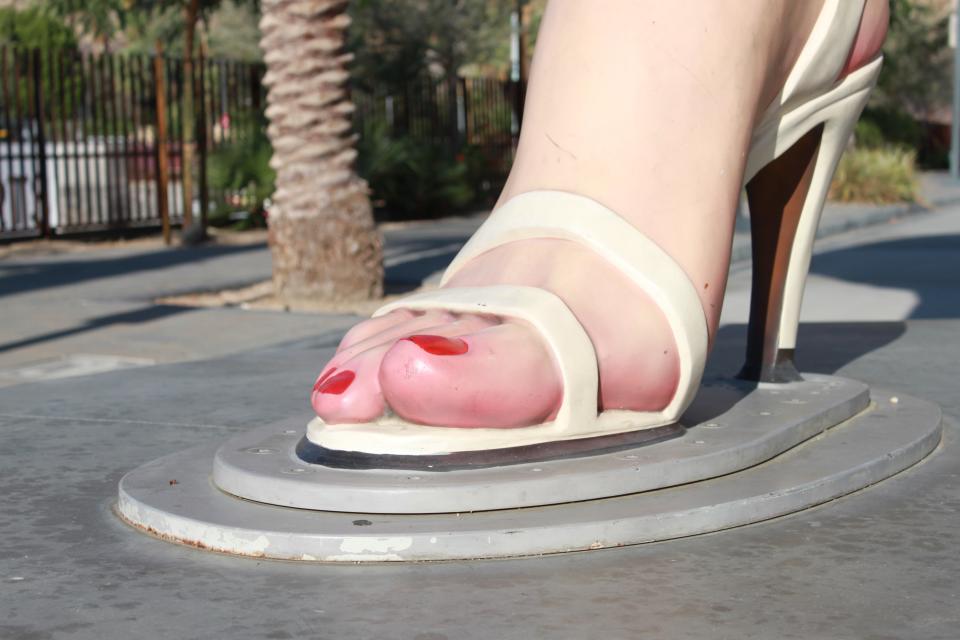
One problem with telling the story of the Palm Springs Marilyn Monroe statue is that the debate now encompasses five years’ worth of disagreement about innumerable tiny logistical details that are, frankly, totally boring—a litany of committee meetings, architectural designs, legal briefs, environmental reports, and legal demurrers.
Here, I’ll try to run through the whole legal history in one paragraph. I bet it will be pretty long. After the statue departed in 2014, P.S. Resorts, which receives its funding through taxes collected from tourists by local hotels and paid to the city, spent years trying to bring Marilyn back. Eventually, they bought the statue for a reported $1 million. Her return became linked to the downtown redevelopment project, with Downtown Park earmarked as a likely location on at least one map. (The opposing sides sharply disagree about how certain this placement was.) In fall 2020, the City Council—meeting, in that pandemic year, via Zoom—heard public comment on a new proposal by P.S. Resorts to locate the statue on Museum Way instead, then voted to authorize a “temporary” closure of the street and the placement of the statue for a three-year trial. Trina Turk launched a GoFundMe for CReMa. In March 2021, CReMa filed suit against the city and P.S. Resorts, arguing that proper procedures for a street closure were not followed. The statue debuted in its new location in June 2021 amid both celebration and protest. (A planned “unveiling” was scrapped due to high winds.) The district court ruled against CReMa the next month without hearing evidence; CReMa appealed the ruling, and in February 2023, a three-judge panel of the California Court of Appeal declared that the city had indeed improperly closed the street—that a three-year closure was not “temporary.” The case was sent back down to the trial court to determine a remedy. That hearing is scheduled for October. In the meantime, P.S. Resorts has launched a campaign to amend the city plan and declare Museum Way permanently vacated.
Whew! At that 2020 City Council meeting, the first public comment came from an impassioned Louis Grachos, the art museum’s then-CEO, who urged the council to reject P.S. Resorts’ proposal, calling the statue “highly offensive to most.” Grachos resigned in 2021; when I asked the current CEO, Adam Lerner, about the museum’s stance on the statue, he was more judicious. “We believe that the 2016 Palm Springs Plan afforded visual access from Palm Canyon to the museum with a road, Museum Way,” he told me. “We would like to see that plan honored. Therefore, we fully support the placement of the statue in another location.”
When I asked Lerner if Marilyn is art, he laughed for precisely one second. “You know, I believe that art is what is made by an artist,” he said. “To me, that issue is not relevant to the conversation about whether or not the statue should be moved 50 feet.” I observed that was sort of not an answer at all. “The museum,” he said, “is not taking up arms about the aesthetics of the sculpture.”
Both sides of the debate seem to understand that basing their position too heavily on value judgments about the statue itself only spotlights the issue’s fundamental absurdity. In the rest of the country, they’re arguing about statues of Confederate generals. In Palm Springs, they’re arguing about Marilyn Monroe’s underpants. This is fitting, perhaps, for a make-believe city, an oasis in the desert created by unsustainable water policies and the Hollywood studio system.
If you want the statue moved and you impugn the statue, you look like a stick-in-the-mud. If you like the statue where it is and you praise the statue, you look like you have bad taste—which is not a crime in Palm Springs but might as well be. The city’s current mayor, Jeffrey Bernstein—who, then a private citizen, supported the statue at the City Council meeting where it was approved—is quick to note, “I don’t think it’s the greatest work of art of all time.” He calls it “an enjoyable piece of public art” that “brings joy to a lot of people.”
Here is where I betray my bias: I think the statue is terrible. Sure, it’s art, whatever. But despite my usual enjoyment of spectacle, kitsch, and tourist trash, I hate it. I take no pleasure in this humorless stance! I do not enjoy agreeing with a bunch of wealthy NIMBYs! Yet when I see the statue from the front, I wince. When I see the statue from behind, I feel embarrassed on humanity’s behalf. When I see tourists taking their picture in front of it, I think: What a shame for those people that they are posting a photo with this dumb statue. I wish the museum would take up arms about the aesthetics of the sculpture, because its aesthetics are hideous. I think the city of Palm Springs should move Forever Marilyn—not 50 feet into a park, but 6,417 miles to the bottom of the Mariana Trench.
Standing tall amid this sea of debate and procedural detail, Forever Marilyn is an inarguable rebuttal to any claim that this argument “isn’t about the statue.” There she is, the statue. Her white dress is positively incandescent in the desert sun. Her bright-red toenails are the size of dinner plates. If you crane your neck and peer closely at her underpants, you can see that Seward Johnson lovingly painted scalloped lace all around their leg holes, a task that must have taken days. In the face of an object so overwhelming, who cares about the Palm Springs city code?
She is what the debate is about, not good governance or post-COVID tourism or rich people doing what they want without opposition. (Everyone involved in this debate is, basically, rich.) Yes, I understand that the specific cause of action behind the court case has to do with street-closure policy—a court case that seems likely to become moot once the city permanently vacates Museum Way. But that is not what this debate is about. This debate is about a huge, tacky statue flashing its underpants at a perfectly nice art museum that doesn’t want it there.
Bernstein, the mayor, views the problem of Forever Marilyn as a possibly unsolvable conundrum—at least one that could never be solved to everyone’s satisfaction. “I work very closely with modernism, preservation, and historic architecture people. I have a lot of respect for the importance of that,” he said. Indeed, the delightful design shop Bernstein owns downtown takes its whole aesthetic from the city’s midcentury flair. “At the same time, I hear how many of our residents love the statue, and love it downtown. It’s not an easy balance to tell one group that this other group overrides it.”
He sighed. “We have homelessness, and we have crime, and this statue has taken up a lot of city time, I will say that. And a lot of money. There’s a lot of lawyers, I think, who have gotten wealthy over this.” He eyed my phone, recording our conversation. “Nothing against the lawyers,” he added.
Bernstein, who is gay, said he’s been a fan of Marilyn Monroe his whole life. (More than 50 percent of Palm Springs is gay, and the city recently made news for its landmark all-LGBTQ City Council. One councilwoman who is married to a man faced whispers that she was faking bisexuality in order to appeal to voters. “Only in Palm Springs,” she said.) “I actually remember writing a college paper on whether she was a feminist icon or just an abused sex symbol,” Bernstein said. “That conversation has gone on for 70 years, basically—whether she knew what she was doing.”
Marilyn certainly knew what she was doing that 1954 night on Lexington Avenue. The New York City press had been encouraged to report that she’d be there that night filming The Seven Year Itch, and almost 2,000 bystanders and photographers filled the street in front of Wright’s grocery store. Director Billy Wilder’s assistant had told the crowd: Wait patiently while we get the shot, and then we’ll move our camera out of the way and you can see. As she walked over a grate in the sidewalk, a gust of wind from a passing 6 train blew her white dress up into the air.
It was all a show, of course. The gust came from an industrial fan installed below the sidewalk. Monroe wore two pairs of underpants to make sure nothing showed. The footage from that night was never even intended to appear in the final film; the point was the photos, which showed up on the movie’s poster, and the press, which covered the photo op wall-to-wall nine months before the movie itself was released. Monroe stayed out in the 50-degree street for two hours, shivering, smiling, letting the public and the photographers have their fill. (Getty Images preserves the original 1954 caption on some of the photos captured that night: “About 1,500 stay-up-late New Yorkers formed an audience, very appreciative, too, as the synthetic breeze unveiled the Monroe legs and nylon whatchamacallits.”) Her then-husband, Joe DiMaggio, tipped off to the spectacle by Walter Winchell, was enraged; the couple argued that night, and some biographers report she had to cover her bruises with makeup the next day. Two weeks later, Monroe filed for divorce.
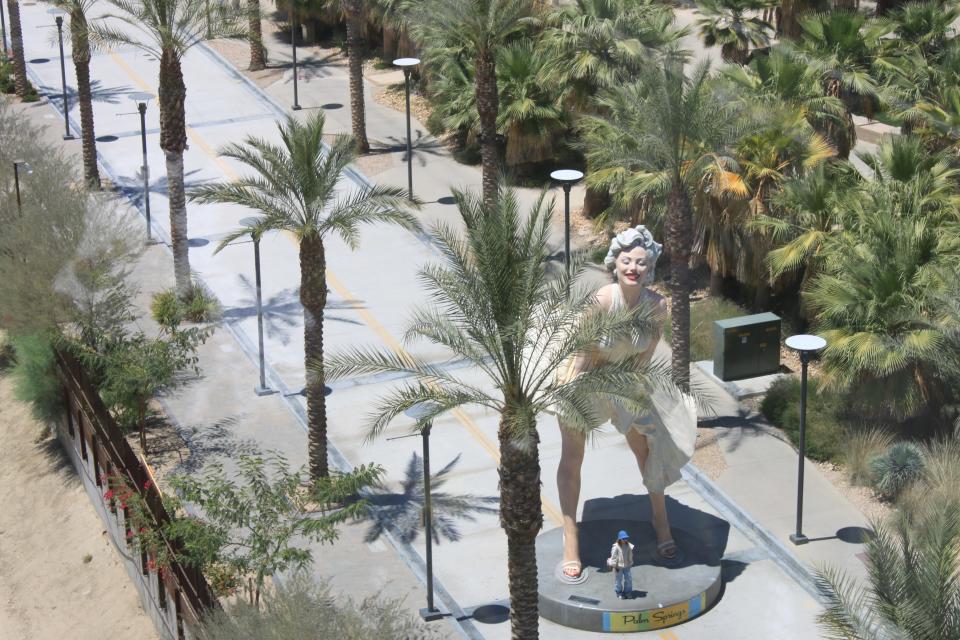
Bruce Hoban is Forever Marilyn’s No. 1 defender. He also happens to be on the board of P.S. Resorts. He was feeling frustrated when we spoke. “It just takes a handful of people who say they represent the majority to bring everything to a halt,” he said.
A tall, gregarious gadfly who met me wearing a vibrant aloha shirt, Hoban spent his career conducting market research for television networks and then working in Silicon Valley, until his husband made him retire after a heart attack. Now he keeps getting involved in various Palm Springs kerfuffles: a battle over short-term vacation rentals, a fight about the establishment of a community college campus in town. He’s the one, he said, who negotiated the purchase with the Seward Johnson Atelier, which disassembled the 30,000-pound statue, loaded it onto several tractor trailers, and sent it across the country. He’s the one who spent “50 different days walking around this area, looking at every possible spot.” When he decided that Museum Way, with its mountain backdrop, was perfect, he’s the person, he said, who made the case to City Council members one by one.
“To our surprise,” he said, “a small group of people decided they did not like the statue here. Trina and her wealthy friends looked for any approach they could take. If they hadn’t found this loophole—not loophole, tactic—if they hadn’t found this legal tactic about temporary closure versus permanent, it would’ve been fine. But it’s going to cost the city and P.S. Resorts, like, over $500,000, just about the freaking way we close the street.”
Above us, Marilyn loomed, forever smiling. One of those pedal saloons pulled up, playing classic rock. A group of older ladies in sun hats clambered out of the saloon and lined up for photos.
Hoban, joined by P.S. Resorts’ executive director, Molly Anderson, addressed what he viewed as the three strands of the anti-Marilyn argument. “OK. A, Marilyn is blocking the view to this stunning architectural art museum. Well, look at that museum!” He pointed down Museum Way. “See all that dark rock? It came out of the mountain behind it. The whole thing was designed to blend into the mountain! Up close it’s really nice, sure. But from here, it’s barely visible.” (He’s not wrong that, from a distance, the museum is visually subtle. Jeffrey Bernstein told me he’s hoping to work out a way to increase visible signage on the façade.)
“Then,” he continued, “there’s this little Me Too movement: ‘Oh my God. You can see the backside under her dress.’ That never came up the first time we had the statue, by the way.” That faction of the Marilyn resistance, which actively protested during the statue’s 2021 launch, is represented in stories by the Los Angeles Times’ art critic, Christopher Knight, who refers to the sculpture as “#MeToo Marilyn” and described it as “a vulgar, misogynistic statue made by a hack artist.”
“And in fact,” Hoban said, “there are highly educated, smart, intelligent, political women in town who don’t like the fact that she’s got an upskirt. OK, that’s fine. That’s an opinion of some people.” For his part, Hoban thinks Marilyn was fully in control of her decisions and thus makes a bad Me Too example. “I just don’t think she was that much of a victim,” Hoban said. He looked up at the statue. “Especially when she became big.”
We walked down the street toward the museum. “And then the third thing is that it would lower the amount of people going to the museum.”
“That by blocking the road and the view, attendance would decrease,” Anderson said.
“But in fact, the opposite has happened. And the museum keeps saying, ‘Oh, our attendance is really, really way up, and we don’t know why.’ ” Hoban and Anderson claim that, due to the upswing in attendance, the museum’s board actually secretly thinks the statue is great. Lerner, the museum’s CEO, told me that the position he articulated reflects the shared opinion of the entire board, and suggested that the museum’s attendance growth is being driven by ambitious new programming, including free Thursday-night parties.
“She did what we wanted her to do,” Hoban said. “She draws people into the area. She’s tremendously popular.”
He’s not wrong about that. Reports from cameras installed by P.S. Resorts measure between 50,000 and 90,000 visitors to the statue per month. A P.S. Resorts survey asked visitors to the statue if they would recommend Forever Marilyn as a “must-see” attraction in Palm Springs. Ninety-nine percent of respondents said yes.
These numbers come from a party with a stake in the matter, but I believe them. During my weekend in Palm Springs, I watched hundreds of people take photos with her. No one scowled, or refused to pose for ethical-feminist-aesthetic reasons. Some people, men and women both, laughingly pointed up at her crotch. More simply stood in front of her massive legs and smiled, or kicked a leg up, or stooped over, holding a dress down, just like her. No one, in short, was a killjoy—except me.
But if tourists love Marilyn, what do actual residents think? Hoban and Turk, unsurprisingly, disagree sharply on this point. Hoban insists the statue is wildly popular among residents, although despite many assurances that survey results were forthcoming, he never could quite get me any documentation. When I asked why Trina Turk felt she represented a silent majority within Palm Springs, he scoffed. “It’s a cause célèbre,” he insisted. “It’s one or two people with some money. Trina Turk’s one of them.”
“Maybe it’s the company I keep, but the vast majority of the people I know in Palm Springs, both full- and part-time residents, are opposed to the current placement,” Turk told me.
“90 percent of gays love Marilyn,” Hoban said. “With non-gay, it drops down—to 70 percent.”
“P.S. Resorts’ statement is what they wish to be true,” Turk said.
Let’s leave them here, debating, and zoom out to take in the sun-blasted city as a whole. When you take off from the Sonny Bono Concourse at the Palm Springs airport you might just catch a glimpse of Marilyn, smiling up at you in the sky. She seems likely to survive this legal challenge, should the city’s plan to vacate the street permanently work. How long will she stay there? The only way I can think about Forever Marilyn and not be annoyed is if I take its title seriously—if I consider the statue’s persistence over geologic time. Ten thousand years from now, when the alien archaeologists marvel that humans could ever have lived in such a place as the Coachella Valley, I hope they’ll dig her up. It makes me happy to imagine them staring at Marilyn’s beautiful face, trying to understand her significance. “Perhaps she was their queen,” they’ll say. “But if so, why did they make such a shitty statue of her?”

